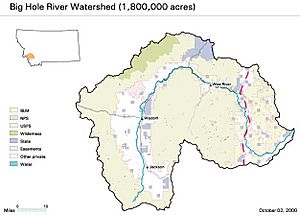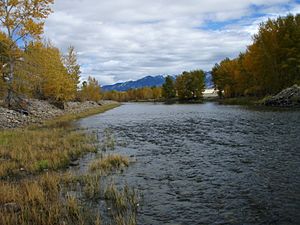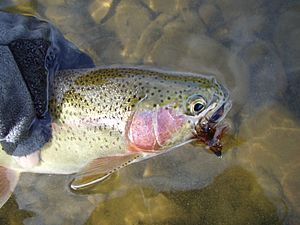Big Hole River facts for kids
Quick facts for kids Big Hole River |
|
|---|---|
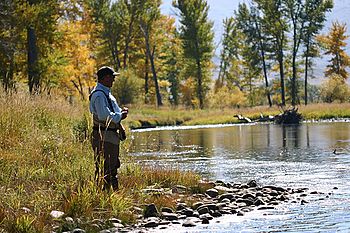
Fly fishing on the Big Hole River Fall of 2006
|
|
| Native name | Sk͏ʷumcné Sewɫk͏ʷs |
| Country | United States |
| State | Montana |
| Physical characteristics | |
| Main source | Skinner Lake, Bitterroot Range, Montana, Beaverhead 7,372 ft (2,247 m) 45°10′22″N 113°30′42″W / 45.17278°N 113.51167°W |
| River mouth | Jefferson River Twin Bridges, Montana 4,610 ft (1,410 m) 45°34′04″N 112°20′21″W / 45.56778°N 112.33917°W |
| Length | 153 mi (246 km) |
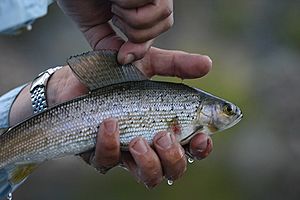
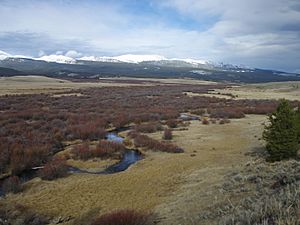
The Big Hole River is a special river in southwestern Montana, United States. It flows for about 153 miles (246 km) through Beaverhead County. This river is a tributary of the Jefferson River.
The local Salish people have a name for it: Sk͏ʷumcné Sewɫk͏ʷs. This means "waters of the pocket gopher." The Big Hole River is very important for nature. It's the last place in the lower 48 states where you can find native river-dwelling Arctic grayling fish. It's also a popular spot for fly fishing, especially for trout.
Contents
River History: Past Explorers and Settlers
The Big Hole River area has a rich history. When the Lewis and Clark Expedition explored this region, it was a neutral zone. Different Native American tribes like the Nez Perce, Shoshone, and Blackfeet used the land.
Lewis and Clark thought about traveling up the Big Hole River. However, they chose the slower Beaverhead River instead. Later, from about 1810 to the 1840s, fur trappers came to the area. They worked for companies like Hudson's Bay Company.
Miners and farmers started settling here between 1864 and the early 1900s. They built ranches along the river. These ranches supplied meat and hay to nearby towns like Butte, Montana, which was a mining center.
The Battle of the Big Hole
In 1877, an important event happened here during the Nez Perce War. U.S. troops, led by John Gibbon, fought the Nez Percé people. This battle is known as the Battle of the Big Hole. Today, the battle site is a protected area called the Big Hole National Battlefield.
Hay-Stacking Innovation
Ranchers needed good ways to feed their cattle in winter. They used wild hay from the meadows. In 1909, Herbert S. Armitage and David J. Stephens invented a "Hay-Stacker." It was called a "beaverslide." This machine helped stack hay easily. It was popular until the 1990s when new machines took over.
River's Journey: Source to Mouth
The Big Hole River watershed covers a large area of about 2,800 square miles (7,252 km2). A watershed is the land area that drains into a river.
The river starts at Skinner Lake. This lake is in the Beaverhead National Forest. It's located in the Bitterroot Range mountains, right on the Continental Divide. This divide separates rivers that flow to the Pacific Ocean from those that flow to the Atlantic.
The Big Hole River flows northwest and then north. It passes by the town of Wisdom. It flows between the Anaconda Range and the Pioneer Mountains. Then, it turns southeast near the town of Wise River, Montana. Here, another river called the Wise River joins it. Finally, near Twin Bridges, the Big Hole River joins the Beaverhead River. Together, they form the Jefferson River.
Protecting the River: Ecology and Conservation
The Big Hole River is important for both nature and people. Sometimes, there are disagreements between ranchers who use river water for their farms and people who enjoy the river for fun activities like fishing.
In the 1960s, there was a plan to build a dam on the river. But conservationists, like George F. Grant, and groups like Trout Unlimited worked with local ranchers. They successfully stopped the dam from being built in 1967.
Saving the Arctic Grayling
The Big Hole River is the only place in the lower 48 states where native river-dwelling Arctic grayling still live. These fish used to live in Michigan and other parts of the Missouri River. There are also lake-dwelling grayling in Montana, but the river-dwelling ones are very rare.
Because these fish are so special, people have worked hard to protect them. In 1995, the Big Hole River Watershed Committee (BHWC) was formed. This group includes ranchers and conservationists. They work together to find solutions for problems affecting the river and its fish.
After many discussions, the U.S. Fish and Wildlife Service (USFWS) decided in 2007 not to list the grayling as an Endangered species. They believed local efforts were enough to protect the fish. This decision caused some debate, but the USFWS confirmed it again in 2014.
Fishing the Big Hole: A Popular Destination
The Big Hole River has been a famous place for serious trout fishing since the late 1880s. Old fishing journals even advertised it as a top spot for catching grayling and trout.
While there are still some native westslope cutthroat trout, they are not very common. Instead, the river has many healthy wild populations of other trout. These include brook, rainbow, and brown trout. These fish were first brought to the Big Hole in the late 1880s. Native Mountain Whitefish also live in the river.
In the 1980s, Montana stopped adding hatchery fish to its rivers. The last hatchery fish were put into the Big Hole in 1990. Today, many guides and fishing lodges offer trips on the Big Hole River.
The river is considered a "Class I water" from the Fishtrap fishing access site down to where it meets the Jefferson River. This means the public has good access to the river for recreation.
| Section | Description | Prevalent Species |
|---|---|---|
| Skinner Lake (Headwaters), Wisdom, MT to Fish Trap (River Mile 81) | This part of the river is slow-moving and flows through high meadows. It ends at the Fish Trap public access site. | This meadow section is home to a few remaining native river-dwelling Arctic Grayling. It also has a good number of Brook trout. Rainbow and brown trout are not as common here. |
| Fish Trap to Melrose | This section flows through a narrow canyon with many boulders. It's a great place for stone fly fishing. There are five public access sites: Sportsman Park, Dewey, Greenwood Bottoms, Powerhouse, and Maidenrock. | In this part of the river, rainbow trout are more common than brown trout, with about 3000 fish per mile. |
| Melrose to Twin Bridges, MT | This section has cottonwood trees along the banks and many braided channels and slow pools. It's also excellent for stone fly fishing. There are several public access sites, including Salmon Fly, Brownes Bridge, Kalsta Bridge, Glen, Notch Bottom, Pennington Bridge, and High Road. | In this stretch, brown trout are more common than rainbow trout, with about 3000 fish per mile. |



